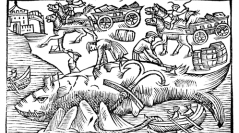

 Anthropozoologica
53 (10) - Pages 115-123
Anthropozoologica
53 (10) - Pages 115-123Medieval studies have returned several times to fisheries and cetacean consumption. The generic term of whale is often used because it is not possible to discern well the species of mammal, or because of ignorance of the diversity of the suborders of mysticetes and odontocetes. With the contribution of cetology, it is maybe useful to take again the file of the ballenae to seek, behind the very poor early Middle Age vocabulary, some species actually encountered. The mentions of cetaceans are topical and start from the description of a monster. Ancient literature delivers to the Middle Ages the vision of a very big and aggressive animal when it comes to the cetus; the delfinus, considered in the same way as all marine animals as a fish, on the contrary carries positive values, but also is surrounded by a fantastic image. To the mystery that surrounds the origin of the whales, necessarily coming from distant seas, is added the even greater mystery of the Atlantic waters, largely ignored by the ancient authors. The early Middle Ages then feature cetacean references combining observations and very succinct encyclopaedic references. The sources suggest two modes of taking: sea fishing and stranded animals capture, which do not allow to specify the animals caught.
Early Middle Ages, whale, dolphin, porpoise, pilot whale.